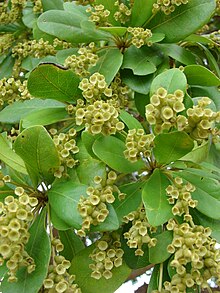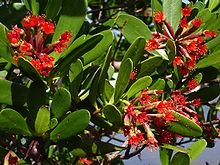Wing seeds
| Wing seeds | ||||||||||||
|---|---|---|---|---|---|---|---|---|---|---|---|---|

Terminalia melanocarpa , branch with leaves, flowers and fruits |
||||||||||||
| Systematics | ||||||||||||
|
||||||||||||
| Scientific name | ||||||||||||
| Combretaceae | ||||||||||||
| R.Br. |
The winged plants or long-thread plants (Combretaceae) are a family in the order of the myrtle-like (Myrtales) within the flowering plants (Magnoliopsida). The 400 to 500 species thrive mainly in the tropics and subtropics .
Description and ecology



Appearance and leaves
The species in the Combretaceae family are woody plants: trees , shrubs and lianas . They grow upright on their own or usually by climbing. The climbing species grow in a twisting manner, Combretum species, for example, twist counterclockwise, or hooks from durable lower areas of petioles hold onto their bases. There are mesophytic to xerophytic (often in savannahs) or helophytic species. Some species are mangroves . Many species shed their leaves in the dry season , or fewer species are evergreen.
The leaves are like most other Myrtenartigen opposite, but there are taxa with alternate and spirally or two to four lines, rarely whorled arranged deciduous leaves. Often the leaves form flat rosettes at the branch ends, which gives many species a characteristic appearance. There are usually petioles present, which in some species remain for a long time and are then thorn-like. The leaf blades are simple. The leaf margin is more or less smooth or sometimes serrated. There are very different trichomes : simple hairs, glandular hairs, multicellular hairs that deposit calcium oxalate and form scales or are present under the cuticle and therefore make the leaf surface appear warty or dotted. There is pinnate and network nerve. Tiny stipules may be present or absent.
Domatia come in about eleven genera and many species, they are usually formed as tufts of hair, sometimes depressions or pockets.
Inflorescences and flowers
The inflorescences are shaped very differently. There are cover sheets .
The flowers are mostly hermaphroditic, but there are also unisexual ones on the same inflorescence. The mostly radial symmetry , rarely at most slightly zygomorphic , mostly four or five-fold flowers often lack the corolla . The mostly four or five sepals are fused to form a more or less long tube. They are inconspicuous or the display device is formed by the stamens . The stamens can be reduced to two. The flower base , designed as a tubular or oval cup, surrounds the ovary . Two or five carpels are fused into a subordinate, single-chamber ovary. The ovary usually contains two, rarely up to six, hanging, anatropic ovules , of which only one develops. There is a discus with nectaries, mostly it is hairy. The style ends in a cephalic or inconspicuous scar.
Fruits and seeds
The solitary, fleshy or dry fruits usually remain closed when ripe, are very variable in their shape and size and often by two to five longitudinal wings (hence the name) or edges to the spreading by wind or cork-like tissue inside or to the spread adjusted by water. The seeds contain two folded, rolled or twisted cotyledons ( cotyledons ), but no endosperm .
Chromosome numbers
The basic chromosome numbers are x = 7, 11 to 13.





Systematics and distribution
The Combretaceae family was established in 1810 by Robert Brown in Prodromus Florae Novae Hollandiae , p. 351. The type genus is Combretum Loef.
The taxa of the following former families are incorporated here: Bucidaceae Spreng. , Myrobalanaceae Martinov , Strephonemataceae Venkat. & Prak. Rao nom. inval., Terminaliaceae J. St.-Hil.
Most species are found in the tropics and subtropics , especially in savannas and monsoon forests . Also mangroves occur in the family.
The Combretaceae family is divided into two subfamilies and two tribes and contains about 16 to 20 genera with 400 to 500 (up to 600) species:
- Subfamily Combretoideae Beilschmied :
- Tribus Combreteae Engler : It contains two subtribes and about nine to twelve genera:
- Subtribus Combretinae: It contains four to five genera:
-
Calycopteris Lam. (Syn .: Getonia Roxb. ): It contains only one species:
- Calycopteris floribunda (Roxb.) Lam. , Syn .: Getonia floribunda Roxb. : It only thrives in the evergreen rainforests of the Western Ghats .
- Long threads ( Combretum Loef. , Syn .: Aetia Adans. , Bureava Baill. , Cacoucia Aubl. , Calopyxis Tul. , Campylochiton Welw. Ex Hiern , Campylogyne Welw. Ex Hemsl. , Chrysostachys Pohl , Cristaria Sonn. , Embryogonia Blume , Forsgardia Vell . , Gonocarpus Ham. , Grislea L. , Hambergera Scop. , Kleinia Crantz , Meiostemon Exell & Stace , Physopodium Desv. , Poivrea Comm. Ex Thouars , Schousboea Willd. , Seguiera Rchb. Ex Oliv. , Sheadendron G. Bertol. , Sphalanthus Jack , Udani Adans. ), Also called bush willow : With around 250 species in the tropics around the world.
- Miracle shrubs ( Quisqualis L. , is sometimes placed in the genus Combretum as a separate section Combretum sect. Quisqualis (L.) Stace ): The approximately 16 species are shrubs or climbing plants from tropical Africa and Asia.
-
Guiera Adans. ex Juss. : It contains only one type:
- Guiera senegalensis J.F. Gmel. : It thrives from Senegal to the Central African Republic.
- Thiloa Eichler : There are only about two species that are common in South America.
-
Calycopteris Lam. (Syn .: Getonia Roxb. ): It contains only one species:
- Subtribus Terminaliinae: It contains about seven genera:
-
Anogeissus ( DC. ) Wall. ex Guill. & Perr. : The ten or so species are common in tropical Africa and Asia, for example:
- Anogeissus latifolia (Roxb. Ex DC.) Wall. ex Guill. & Perr.
- Anogeissus leiocarpa (DC.) Guill. & Perr.
- Buchenavia Eichler : About 20 species are common in the Neotropic .
-
Bucida L. nom. cons .: The approximately six species occur in Florida, Central America and on the Caribbean islands. Including:
- Bucida buceras L .: It is also placed under the genus Terminalia by some authors.
-
Conocarpus L .: The only two species occur in tropical Africa and in the Neotropics :
- Button mangrove ( Conocarpus erectus L. ): It is a salt-tolerant tree of the coastal region of West Africa and the Neotropics.
- Conocarpus lancifolius Engl .: Home is northeast Africa and southern Yemen .
- Pteleopsis Engl .: The ten or so species are common in Africa.
-
Myrobalans ( Terminalia L. , Syn .: Adamaram Adanson , Badamia Gaertner , Buceras P.Browne , Myrobalanus Gaertner , Pentaptera Roxb. ): The approximately 150 species are distributed in the tropics around the world, e.g. B .:
- Katappenbaum ( Terminalia catappa L. )
- Terminaliopsis Danguy : There are at most two species in Madagascar.
-
Anogeissus ( DC. ) Wall. ex Guill. & Perr. : The ten or so species are common in tropical Africa and Asia, for example:
- Subtribus Combretinae: It contains four to five genera:
- Tribus Laguncularieae Engler & Diels : It contains four genera:
- Dansiea Byrnes : The only two species occur in Australia.
-
Laguncularia C.F. Gaertn. : It contains only one type:
- White Mangrove ( Laguncularia racemosa (L.) CFGaertn. ): It has an Atlantic distribution with occurrences in West Africa and the New World.
-
Lumnitzera Willd. : With two mangrove species with Pacific distribution in East Africa and Northern Australia :
- Lumnitzera littorea (Jack) Voigt
- Lumnitzera racemosa Willd.
- Macropteranthes F. Muell. : The five or so species occur in Australia.
- Tribus Combreteae Engler : It contains two subtribes and about nine to twelve genera:
- Subfamily Strephonematoideae Engler & Diels : It contains only one genus:
- Strephonema Hook. f. : The three or so species are common in tropical West Africa.
swell
- The Combretaceae family on the AP website . (Sections Description and Systematics)
- The Combretaceae family at DELTA by L. Watson & MJ Dallwitz. (Section description)
- Jie Chen, Nicholas J. Turland: Combretaceae , p. 309 - the same text online as the printed work , In: Wu Zheng-yi, Peter H. Raven & Deyuan Hong (eds.): Flora of China , Volume 13 - Clusiaceae through Araliaceae , Science Press and Missouri Botanical Garden Press, Beijing and St. Louis, 2007, ISBN 978-1-930723-59-7 . (Section description)
Individual evidence
- ↑ Combretaceae at Tropicos.org. Missouri Botanical Garden, St. Louis
- ↑ Combretaceae in the Germplasm Resources Information Network (GRIN), USDA , ARS , National Genetic Resources Program. National Germplasm Resources Laboratory, Beltsville, Maryland.
